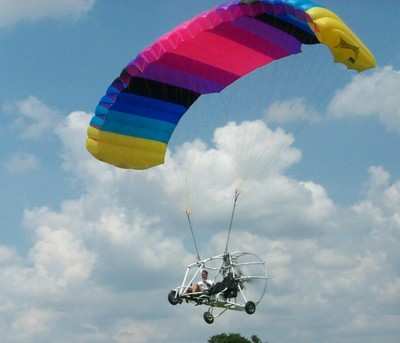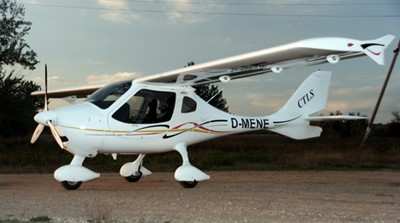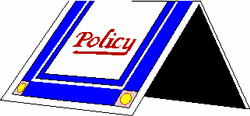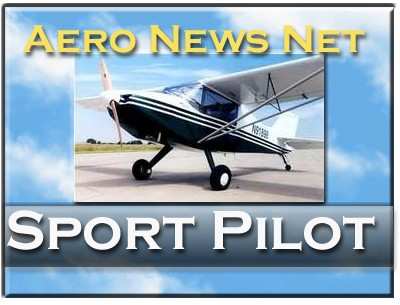Training in Experimentals Returns, But Challenges Remain
Aero-Analysis by ANN Senior E-Media Producer, Paul Plack
The FAA has issued a long awaited and desperately needed
document with instructions to its Field Service District Offices
(FSDO) on the issuance of Letters of Deviation Authority (LODA)
allowing compensated flight instruction in experimental aircraft.
For some aircraft classes, such aircraft are the only reasonably
available trainers in the US, and an FAA block on new LODA three
years ago, and the end of training in E-LSAs last year, has all but
wiped out access to primary training for some pilots at the
low-cost end of the general aviation spectrum.

The details of the new guidance, however, are not all good news.
A transition period ending January 31, 2010 was intended to provide
time for instructors using two-seat trainers formerly known as "fat
ultralights" and grandfathered as Experimental Light Sport Aircraft
(E-LSA) to transition to new training aircraft certified as Special
Light Sport Aircraft (S-LSA). Due to economic conditions and other
factors, most instructors in low, slow aircraft such as powered
parachutes couldn't make buying new aircraft pencil out.

The FAA did not adapt to this reality, despite data which,
according to David Oord, Government & Advocacy Specialist with
the Experimental Aircraft Association (EAA), shows no fatal
accidents among fat ultralights over the five-year transition
period. Oord says the impact was most dramatic for pilots in
low-mass, high-drag aircraft with maximum speed in level flight at
maximum continuous power (VH) of 87 knots or less, a class
requiring a specific endorsement. Oord observes, "I think there
were four S-LSAs actually out there that have a VH less than 87
knots, which means if I want to get my endorsement, I have to go
seek out one of these four aircraft, find an instructor to fly in
that aircraft...it's just not a very feasible way to get your
training."

The new FAA guidance allows those instructors in former fat
ultralights to apply for a new LODA to resume training, provided
they owned the machines before January 31, 2010, and provided there
are currently no S-LSA trainers available in their districts. This
is somewhat analogous to having your conviction reversed after
being hanged. There are no good numbers available, but it is
suspected many former instructors sold their machines during the
year-plus grounding. Oord says the FAA left the door open to
revisit the specifics of the guidance if inadequate training access
remains a problem. Also returning is authorization to train pilot
to operate ultralight vehicles qualifying under Part 103 in
two-seat E-LSA aircraft under 500 pounds.

For gyroplane pilots, things are a little different. The FAA's
Rotorcraft Directorate has blocked the sale of factory-built
gyroplanes with S-LSA or E-LSA certificates, (despite the
availability of the Sport Pilot certificate for gyros,) and there
have been no new Part 27 certificated gyroplanes available in the
US in decades, so all gyroplane training in light-sport-class gyros
is done in Experimental Amateur Built (EAB) machines. With no new
LODA available for three years, availability of primary gyro
training has dwindled to just over a dozen machines in the US, most
located east of the Mississippi River. Rentals of experimentals is
expressly prohibited, so the only way to complete solo requirements
for the Private (or higher) Rotorcraft/Gyroplane certificate, or
even fly occasionally to maintain proficiency, is to own your own
aircraft.

If you can imagine a scenario in which airplanes were not
available for rent, and the only way to complete training for the
Private certificate or even maintain proficiency was to own your
own plane, it's pretty obvious what would happen to the number of
active airplane pilots. This is the regulatory cave in which the
FAA still forces the gyroplane sector to live. The new guidance
does reopen the LODA door for gyroplanes, allows primary training
for Sport Pilot up through Private, Commercial and Instructor
gyroplane ratings, and allows flight reviews. This will break the
drought in new instructors, who have been unable to bring new
training aircraft online for three years.

On its face, the new document (8900.1 CHG 155, dated May 24,
2011 and now available to a FSDO through the FAA's FSIMS document
system) looks as if it may empower local offices to expedite the
LODA process for applicants meeting the conditions. In its
background section it promises, "The FAA recognizes the value of
specialized flight training that may only be available in aircraft
holding experimental certificates." But it's clear the FAA does not
yet recognize (or care) that even its revised policy leaves major
roadblocks in place to those diligently seeking training in
affected aircraft classes.

LODAs are specifically limited to 24 months maximum duration
under the new guidelines, setting up a recurring administrative
burden for instructors. Given the protracted approval process,
which may vary widely among individual FSDO, it also risks gaps in
an individual instructor's availability. The new LODA will be
limited to the geographical area of the FSDO issuing the authority,
which blocks instructors from traveling to instruct at distant
fly-ins where an itinerant CFI might be the only available option.
And the letters themselves will contain wording allowing withdrawal
of the authority at any time without cause, which is a potential
deal-breaker for instructors who need bank loans to bring a new
aircraft into the training fleet.

Underlying these compromised instruction policies is an
unwillingness by the FAA to admit that two big reasons for the
proliferation of experimental aircraft are the costs of
manufacturer's liability insurance, which bloats the purchase price
of new aircraft with Standard Airworthiness Certificates, and the
crushing financial burdens imposed by Part 23 and 27 on the
developers of new aircraft types serving niche markets. In 2010,
there were more piston aircraft built in garages by US citizens
than in the factories of the world, in part because for many
pilots, ownership of an LSA priced in six digits is an "entry
level" beyond their reach.

It is encouraging to hear that EAA has a commitment from the FAA
to revisit the new LODA policy if it doesn't work, but it's unclear
what the definition of "work" will be, or whether it will take
another three years for the next step. The first few reports from
instructors on wait times for handling of LODA applications will
shape an expectation of how long the biennial renewals might take.
It might be wise for would-be pilots in general aviation's true
entry level, the low-and-slow experimentals, to get training while
you can. While you're at it, get at least a Sport Pilot rating in a
traditional airplane, because it could one day be the only way to
get a flight review and stay legal to fly your PPC, trike or
gyro.

An wide-ranging conversation on this issue with EAA's David Oord
has been released in two installments in the Aero News Special
Features for June 7 & 8, 2011.
 ANN's Daily Aero-Linx (04.16.24)
ANN's Daily Aero-Linx (04.16.24) Aero-News: Quote of the Day (04.16.24)
Aero-News: Quote of the Day (04.16.24) Airborne 04.10.24: SnF24!, A50 Heritage Reveal, HeliCycle!, Montaer MC-01
Airborne 04.10.24: SnF24!, A50 Heritage Reveal, HeliCycle!, Montaer MC-01 Airborne 04.12.24: SnF24!, G100UL Is Here, Holy Micro, Plane Tags
Airborne 04.12.24: SnF24!, G100UL Is Here, Holy Micro, Plane Tags Airborne-Flight Training 04.17.24: Feds Need Controllers, Spirit Delay, Redbird
Airborne-Flight Training 04.17.24: Feds Need Controllers, Spirit Delay, Redbird












